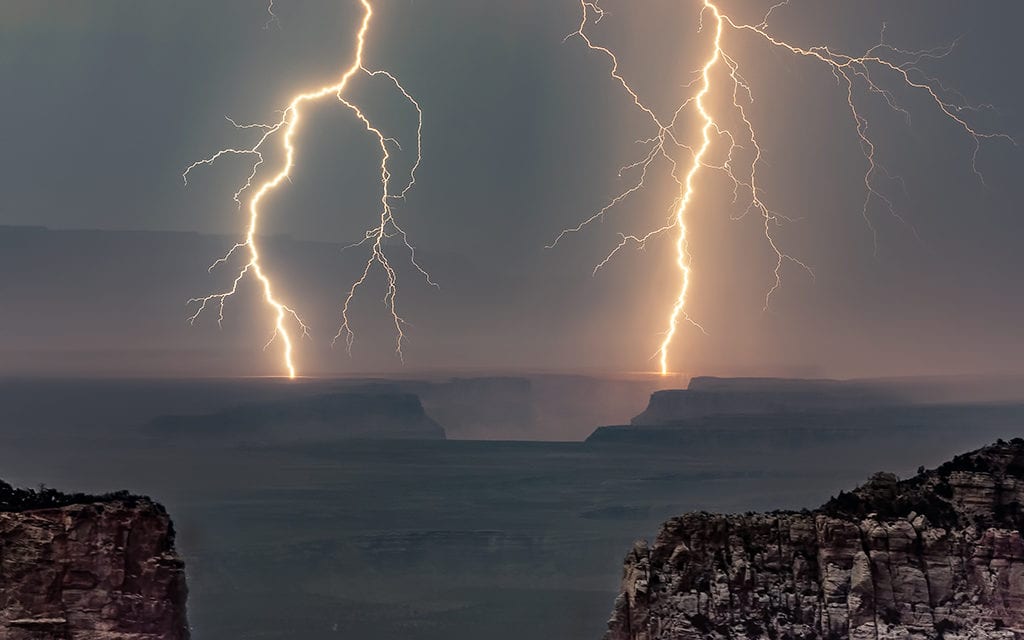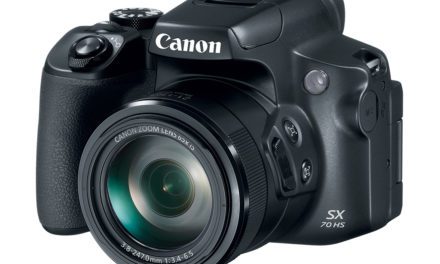Few things in nature are more dramatic or unpredictable than lightning—or more dangerous. The more you understand lightning, how to anticipate it and what to do in its presence, the safer you’ll be and the more success you’ll have photographing lightning.
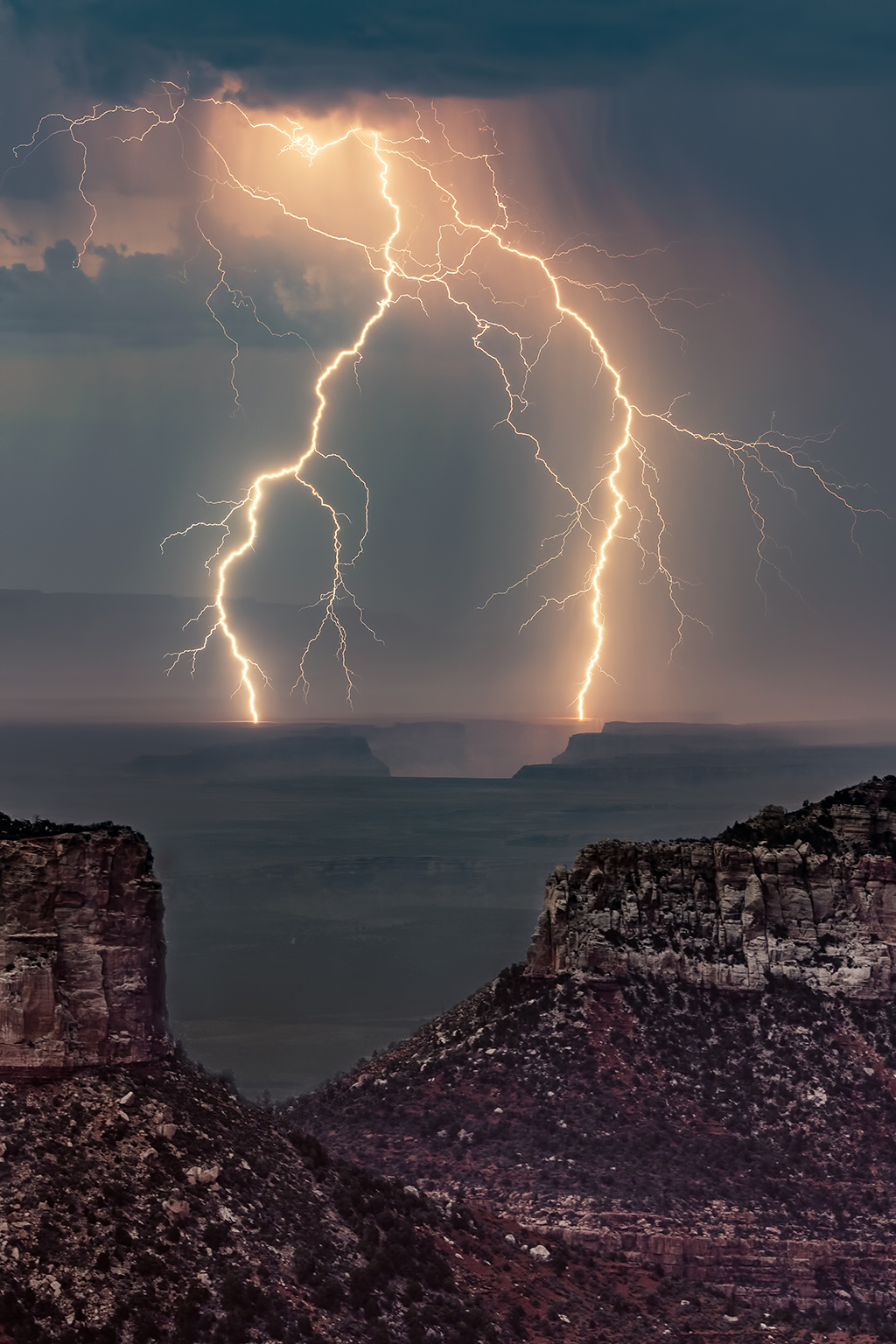
Forked Lightning, Point Imperial, Grand Canyon. This storm started out by the Vermilion Cliffs, but I was able to bring it closer with my 100-400mm lens.
The “Shocking” Truths About Lightning
A lightning bolt is an atmospheric manifestation of the truism that opposites attract. In nature, we get a spark when two oppositely charged objects come in close proximity. For example, when you get shocked touching a doorknob, on a very small scale, you’ve been struck by lightning.
In a thunderstorm, the up/down flow of atmospheric convection creates turbulence that knocks together airborne molecules, stripping their negatively charged electrons. Lighter, positively charged molecules are carried upward in the convection’s updrafts, while the heavier negatively charged molecules remain near the bottom of the cloud. Soon the cloud is electrically polarized, more positively charged at the top than at the base.
Nature always takes the easiest path. If the easiest path to electrical equilibrium is between the cloud top and bottom, we get intracloud lightning. If it’s between two different clouds, we get intercloud lightning. Less frequent cloud-to-ground strikes occur when the easiest path to equilibrium is between the cloud and ground.
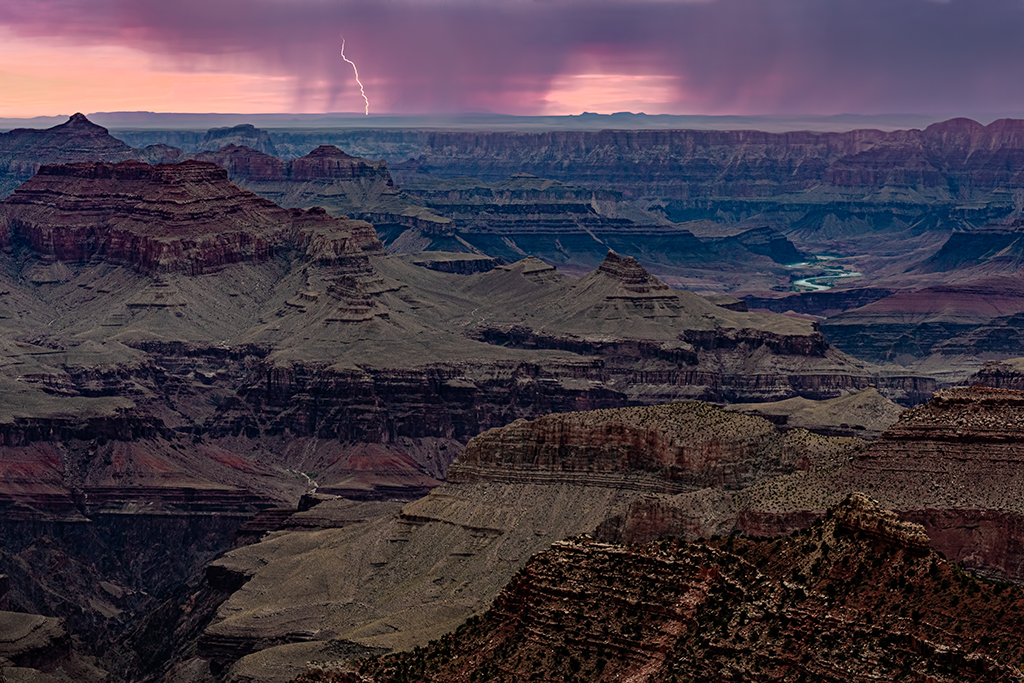
Twilight Lightning, Grandview Point, Grand Canyon. I was driving the road to Desert View at around sunset and pulled over at Grandview Point when I saw the sky light up and lightning firing in the east.
With lightning comes thunder, the sound of air expanding explosively when heated by a 50,000-degree jolt of electricity. Thunder travels at the speed of sound, a pedestrian 750 miles per hour, while lightning’s flash zips along at the speed of light, more than 186,000 miles per second.
Knowing that the thunder occurred at the same time as the lightning flash, and the speed both travel, we can calculate the approximate distance of the lightning strike. While we see the lightning instantaneously, thunder takes about five seconds to cover a mile. Dividing the number of seconds between the lightning’s flash and the thunder’s crash by 5 gives you the lightning’s distance in miles.
How To Photograph Lightning Safely
The thousands of humans killed by lightning each year have one thing in common: None believed they’d be struck by lightning. The safest place in an electrical storm is a fully enclosed structure or metal-framed vehicle (it has nothing to do with the tires), windows closed and away from windows, plumbing, wiring and electronics.
The surest way to be struck by lightning is to be outside in an electrical storm, but photographing lightning usually requires being outside. And while there’s no completely safe way to photograph lightning, it doesn’t hurt to improve your odds of avoiding injury.
Most lightning strikes are within a six-mile radius of the previous strike, but strikes have been known to happen much farther from the storm. Since thunder isn’t usually audible beyond 10 miles, if you hear thunder, you should go inside and stay there until at least 30 minutes after the thunder stops.
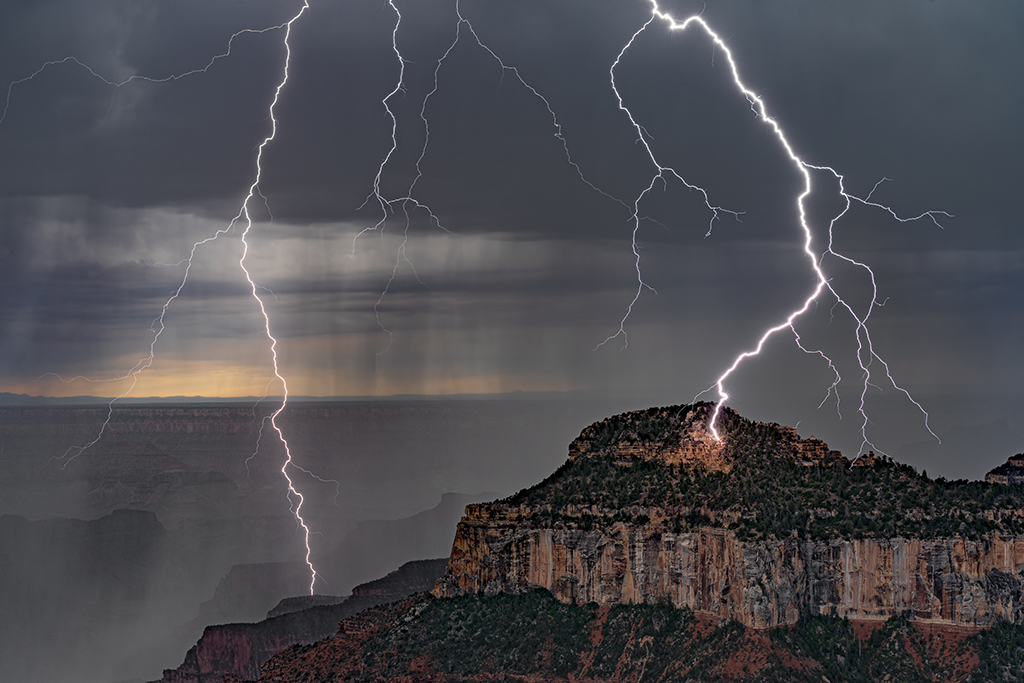
Lightning Explosion, Osa Butte, Grand Canyon North Rim. Set up on the Grand Canyon Lodge viewing deck with my workshop group, we watched this storm approach. This strike, about a mile away, was the signal to go inside.
If you absolutely must be outside with lightning nearby, or you simply find yourself caught outside with no available shelter, put safety first!
Things you should know and do to be safer when photographing lightning:
- A lightning strike is often preceded by static electricity that makes your hair stand on end.
- Avoid high ground.
- Avoid exposed areas.
- Avoid metal and electronics.
- Avoid concrete, which is often reinforced with metal.
- Avoid tall isolated objects such as trees and open structures (and tripods).
- Avoid water.
- Stay at least 15 feet from other people.
- Do not lie down.
- If you’re surrounded by trees, position yourself near shorter trees, as far from trunks as possible.
- Rubber-soled shoes provide no protection.
- As a last resort, crouch on the balls of your feet, with your feet together and your hands covering your ears.
Equipment For Photographing Lightning
If, after factoring in all the risks, you still like the idea of photographing lightning, you need to gear up. The extreme contrast between darkness and brilliant lightning means photographing lightning at night is mostly a matter of pointing your camera in the right direction with a multi-second shutter speed and hoping the lightning fires while your shutter’s open—pretty straightforward.
Photographing daylight lightning is more problematic. It’s usually over before you can react, so any success just watching and clicking is probably just luck. And using a neutral density filter to stretch the exposure time out to multiple seconds sounds great in theory, but in daylight, a lightning bolt with a life measured in milliseconds, captured in an exposure measured in seconds, will almost certainly lack the contrast necessary to show up in an image.
A lightning sensor is the key to consistent lightning photography success. This device attaches to your hot-shoe and connects to your camera’s remote port (where you plug in your remote cable). In action, the sensor detects the visible and/or infrared wavelengths of a lightning bolt and fires the shutter almost instantaneously. There are many devices out there that claim to catch lightning, but some are much better than others. Rather than trusting the manufacturer’s marketing claims (which I’ve found to be unreliable), try to find someone who has used and can recommend one. Lacking that, read the sensor’s reviews (don’t just count its rating stars). Of the many lightning sensors to choose from, in my experience, the Lightning Trigger from Stepping Stone Products is the most reliable and is what I recommend to all my workshop students.
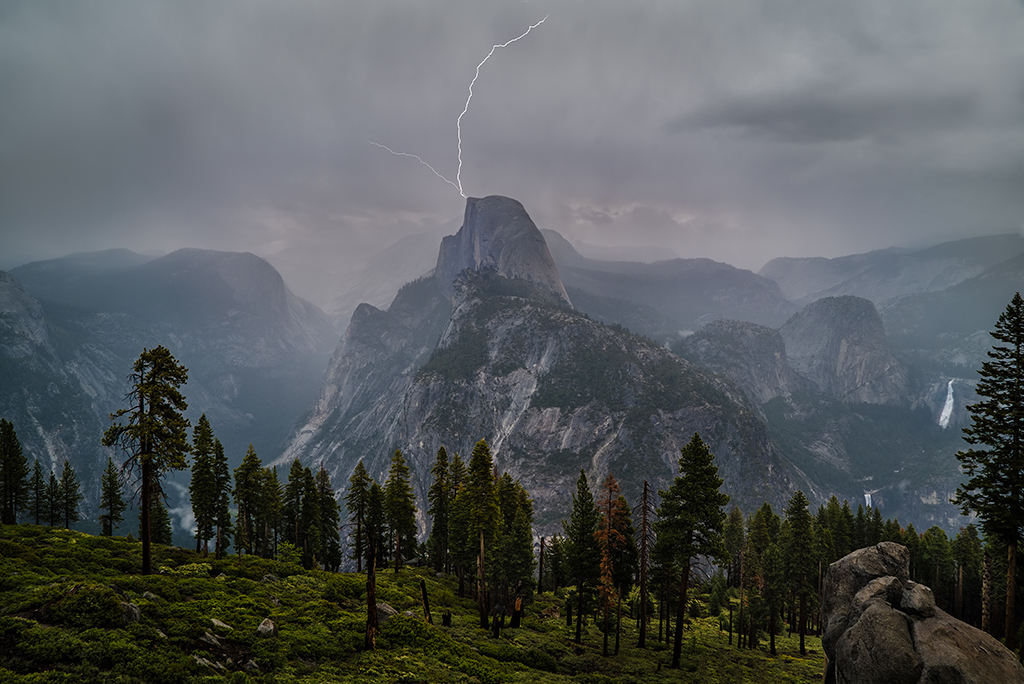
Direct Hit, Lightning Strikes Half Dome, Glacier Point, Yosemite. Lightning is relatively rare in Yosemite, but when the forecast looked promising for this July afternoon, I beelined to the park and set up at Glacier Point.
Lightning is fast—really, really fast—so the faster your camera’s shutter responds after getting the command to fire, the more success you’ll have. The delay between the click instruction (whether from your finger pressing the shutter button, a remote release, or a lightning sensor) and the shutter firing is called “shutter lag.”
In general, interchangeable lens cameras (mirrorless and DSLR) have the fastest shutter lag. But even with these cameras, it’s surprising how much shutter lag varies from manufacturer to manufacturer and even between models from the same manufacturer.
Ideally, your camera’s shutter lag should be 60 milliseconds (0.06 seconds) or faster, but 120 milliseconds (0.12 seconds) is usually fast enough. Most of the top cameras from Sony, Nikon and Canon are fast enough.
Shutter lag can vary with the manufacturer’s model. While my Sony a7R IV may be the fastest camera out there, my original a7R was unusably slow, so you need to check your model’s shutter lag. Unfortunately, shutter lag isn’t usually in the manufacturers’ specifications. The best source I’ve found is the “Prefocused” time in the Performance tab of the camera reviews at Imaging Resource.
Shutter lag varies a lot, depending how your camera is set up. To minimize the camera’s “thinking” before firing, you should use manual focus and metering. If your camera offers an electronic front curtain option (as my Sony cameras do), use it.
In addition to a lightning sensor and fast camera, you’ll need:
- A solid tripod and head. Lightning photography is all about waiting with the camera ready to fire, so trying to photograph lightning hand-held is a quick path to arm and eye fatigue.
- Rain gear that keeps you dry from head to toe.
- Umbrella to shield your camera and lightning sensor (some aren’t waterproof) while you compose and wait in the rain. I rarely use an umbrella because if the lightning is firing in the same cell that’s getting me wet, I’m too close.
- Lens hood to shield some of the raindrops that could collect on the front element of your lens.
- Neutral density filter and/or polarizer to slow shutter speed into the ideal range (more on this later).
- A garbage bag to keep your camera and lightning sensor dry while you wait out a downpour.
- A rainproof camera jacket might let your camera keep shooting while you hide out in the car.
- Extra lightning sensor batteries because better safe than sorry.
- Extra memory cards. Cards fill fast when a storm is very close or active and your lightning sensor detects 30 strikes per minute (even when little or no lightning is visible to the eye).
- A towel.
Photographing Lightning: Getting The Shot
Even if you can photograph lightning from your front porch, it’s usually best to pick a nice scene, then monitor the weather so you can be there to capture lightning with a great foreground.
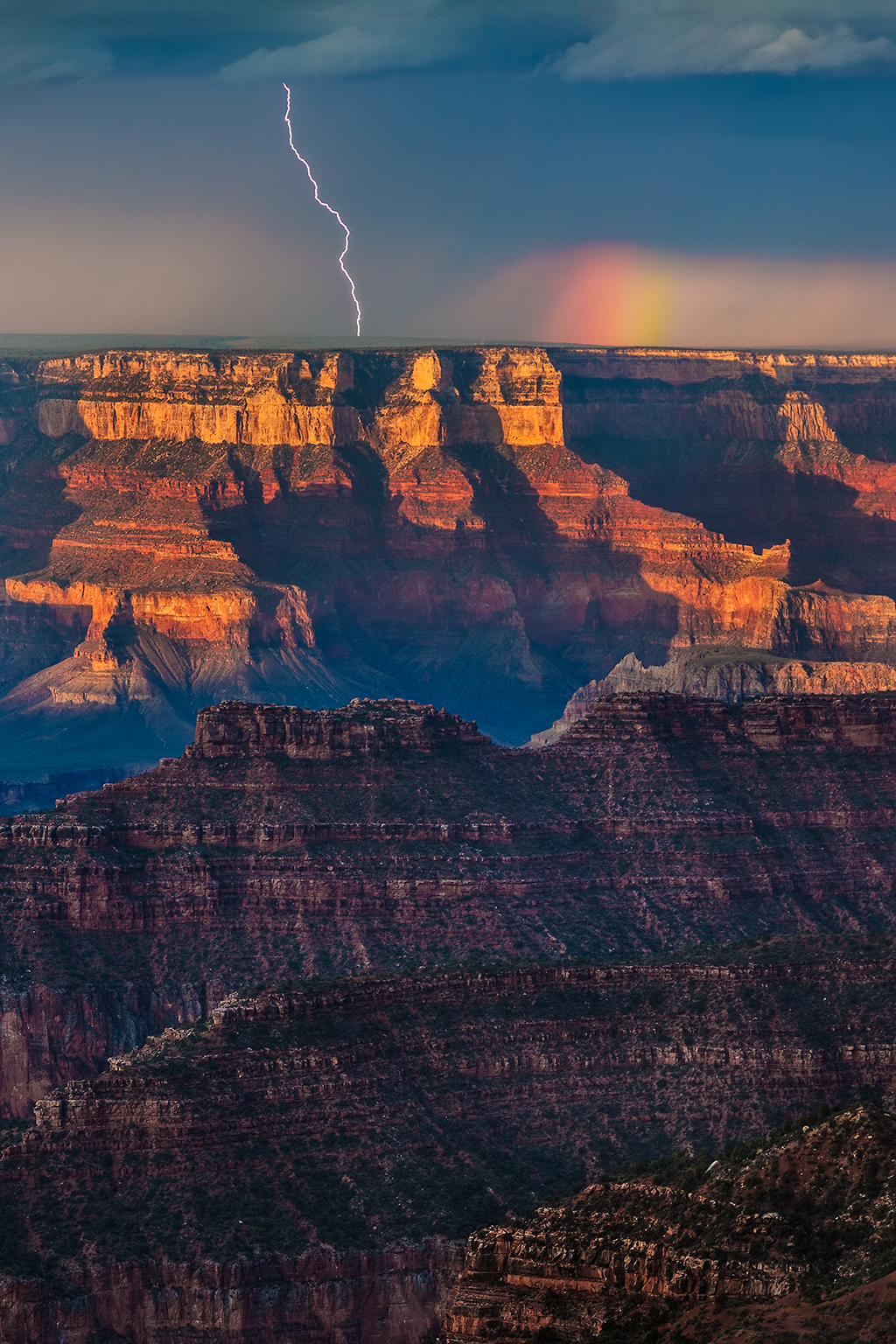
Lightning and Rainbow, Grand Canyon. One of the most spectacular lightning displays I’ve ever witnessed got even better when a small but vivid rainbow joined the party.
I strongly recommend that you scout these lightning scenes in advance, not just for possible compositions but also for safe places to set up, escape routes and somewhere to retreat to if the lightning gets too close. I try never to shoot more than a quick sprint from my car.
Once you’re there, don’t wait until you see lightning before preparing your gear. If the sky looks even a little promising, get everything ready: tripod out, camera and lens mounted, lightning sensor attached. Then test your sensor to make sure it fires—I can’t tell you how easy it is to overlook one little thing and wonder why the lightning is firing, but your camera isn’t. I test my Lightning Triggers with an infrared TV remote or with the flash from my iPhone camera.
The trickiest part of lightning photography is getting the right shutter speed. With too fast a shutter speed you risk missing the strikes; too long and you risk washing out the lightning. My target shutter speed is usually 1/8 sec., plus or minus 1/8 sec.—long enough to include multiple pulses but not so long that I risk washing out the lightning.
When the sky is relatively bright, dropping to 1/20 sec. can help the lightning stand out better than 1/8 sec. but risks losing secondary strikes. Conversely, when the sky is extremely dark and the lightning is firing like crazy, extending to 1/4 sec. might increase your chances for capturing multiple pulses.
Even with a polarizer on, getting the shutter speed to my sweet spot sometimes requires dropping to ISO 50 and stopping down to ƒ/16 or smaller. In these situations, a neutral density filter is a big help, but take care not to let the shutter speed go longer than necessary.
Lightning is most likely to strike in or near the gray curtains (clearly recognizable as distant rain) that hang beneath dark clouds—not only near the center but often on the fringe or just outside. The darkest and tallest clouds are usually the most likely to fire lightning. If you’re in the storm you’re photographing, you’re too close.
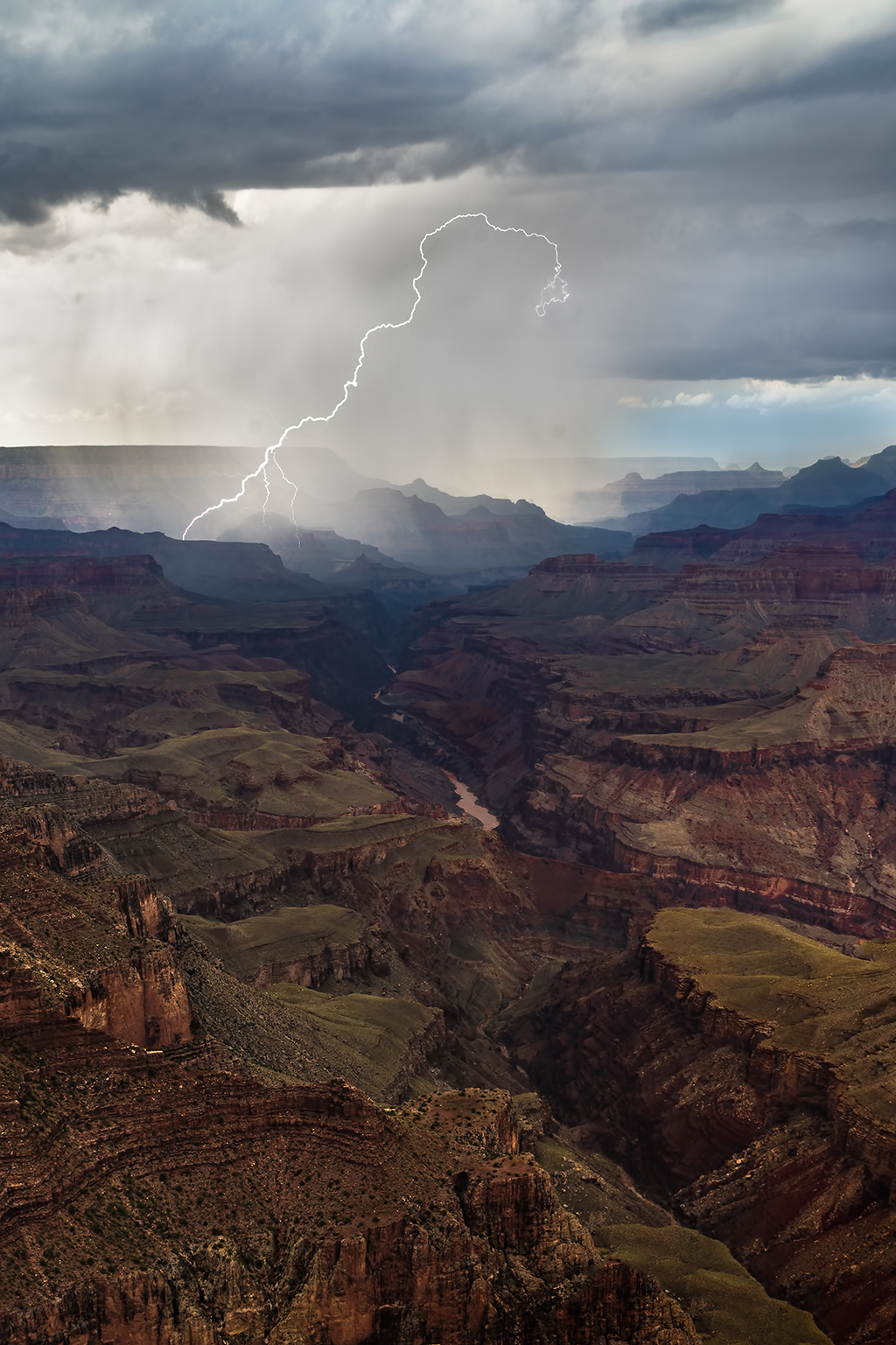
Diagonal Lightning, Lipan Point, Grand Canyon. Set up at Lipan Point, I watched this storm move up from the south and crossed my fingers that it would hold together until it reached the canyon.
The best lens for lightning is usually a midrange zoom, such as a 24-70mm or 24-105mm. If you find yourself reaching for your 16-35mm (or wider), you’re too close.
I generally start fairly wide, but once I’m sure I’ve captured some good strikes, I usually compose tighter. While this narrower field of view can reduce the number of frames with lightning, the ones I get are much larger in the frame.
Here are a few more composition points to consider for photographing lightning:
- Identify the most likely lightning cell and find the best composition that includes it.
- The more resolution you have, the looser you can compose, then crop to the best composition later.
- Don’t include too much room above the lightning—the most frequent rookie mistake I see is too much sky and clouds in the frame. I like my lightning bolts to originate just below the top of my frame.
- The second most frequent rookie mistake I see is lightning cut off at the top. Note the height from which the lightning originates and try to include enough cloud to get the stroke’s origin point. If you’re shooting really wide and still can’t get all the lightning, run!
- Don’t forget to try some vertical compositions.
There’s a lot of standing around while photographing lightning, but storms move, so the more you can keep your eyes on the sky, the better you’ll be at keeping lightning in your frame as the storm moves. The light can change by several stops as the storm moves, intensifies or winds down, so check your exposure frequently. Monitor your surroundings for active cells moving up behind you.
Rainbows Often Follow Lightning
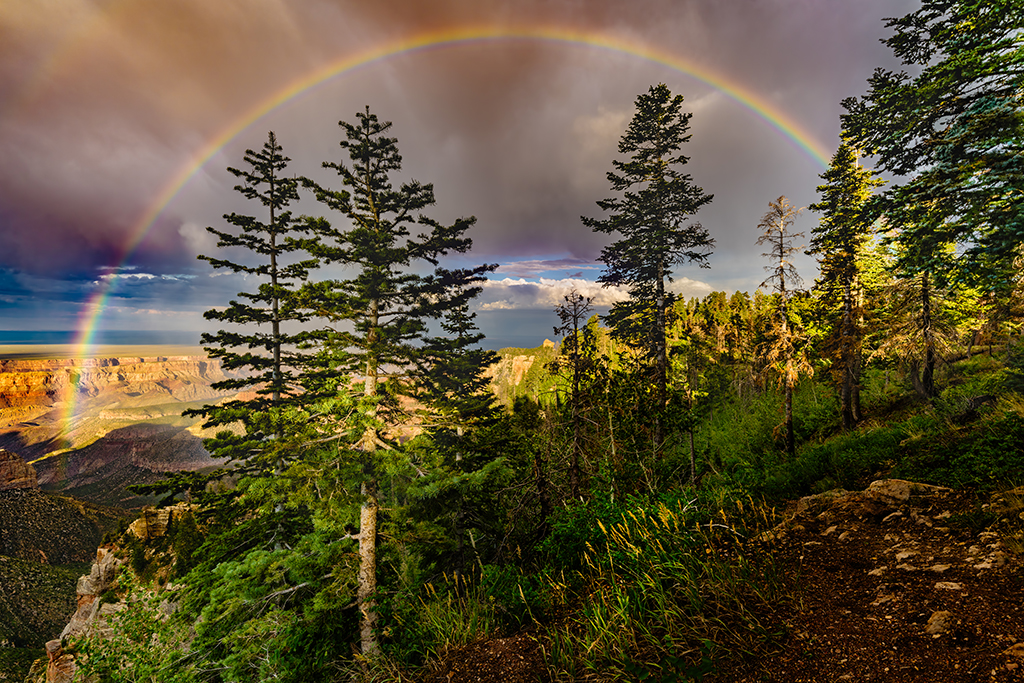
Full Rainbow, Vista Encantada, Grand Canyon. My workshop group watched this rainbow form and hang in the sky while we sped to the canyon rim for a better view. Fortunately, it hung in there long enough for us to make it to the first viewpoint on the Cape Royal Road, Vista Encantada.
If lightning is the main course, a rainbow is the dessert. The recipe is simple: sunlight on raindrops when the sun is behind you and less than 42 degrees above the horizon.
Since electrical storms tend to be showery in nature, when photographing lightning, you should always prepare for the possibility the sun will break through while the rain still falls. One of the first things I do when I set up for a lightning shoot is take note of where a rainbow would appear and mentally prepare compositions.
A rainbow makes a circle at 42 degrees around the antisolar point. (For the antisolar point, imagine a line from the sun through your head and out between your eyes), so your shadow always points to the center of the rainbow. If you had a polarizer on while photographing lightning, don’t forget to check its orientation—or just remove it—if a rainbow pops out.
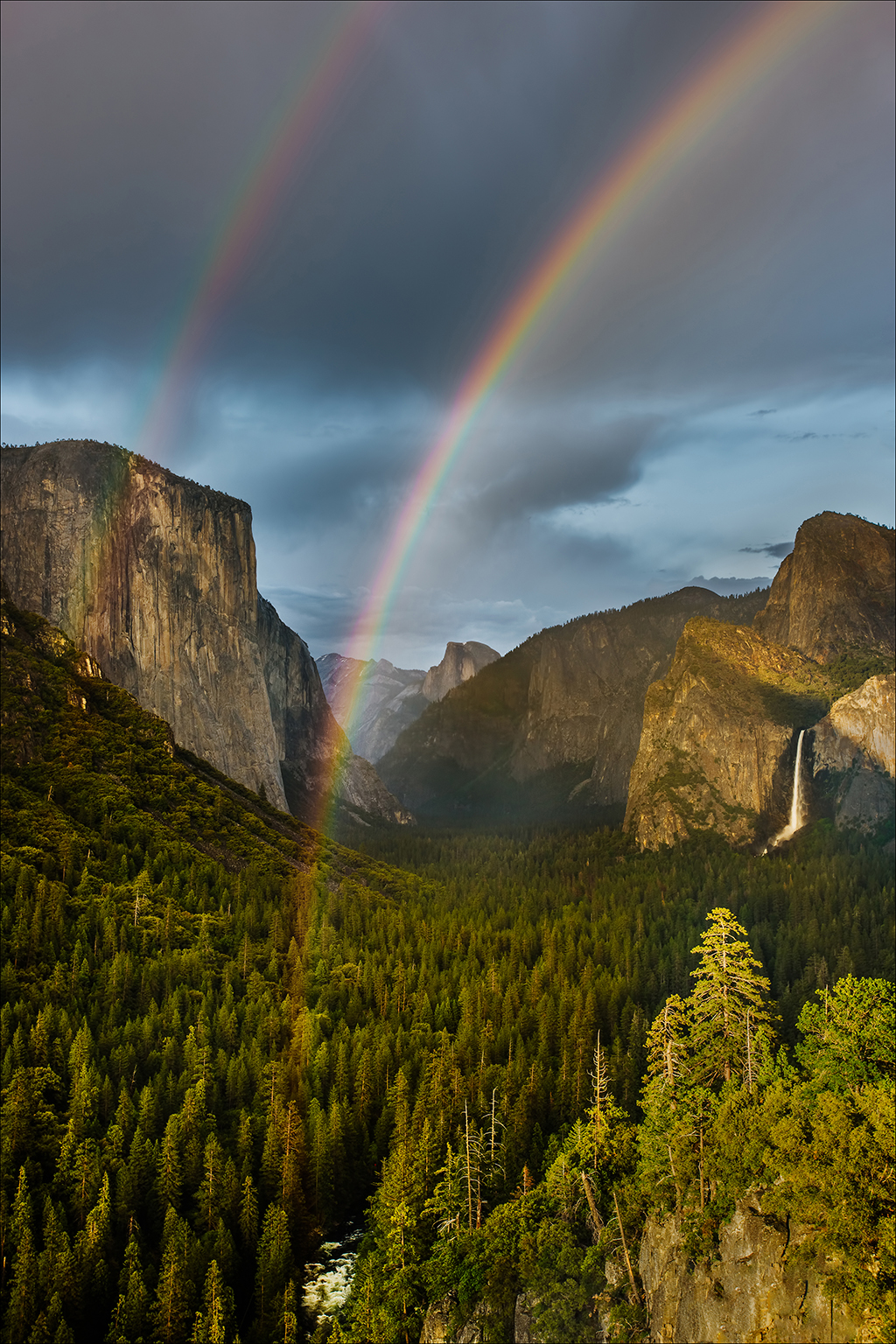
Double Rainbow, Yosemite Valley. Knowing that a rainbow was possible, I changed my plans and waited in a downpour for the sun to come out.
Be Safe When Photographing Lightning
Lightning photography can be thrilling, but sometimes the desire to get the shot overrides good sense. Be smart, don’t take chances and live to photograph another day.
The post Lightning Strike! appeared first on Outdoor Photographer.

